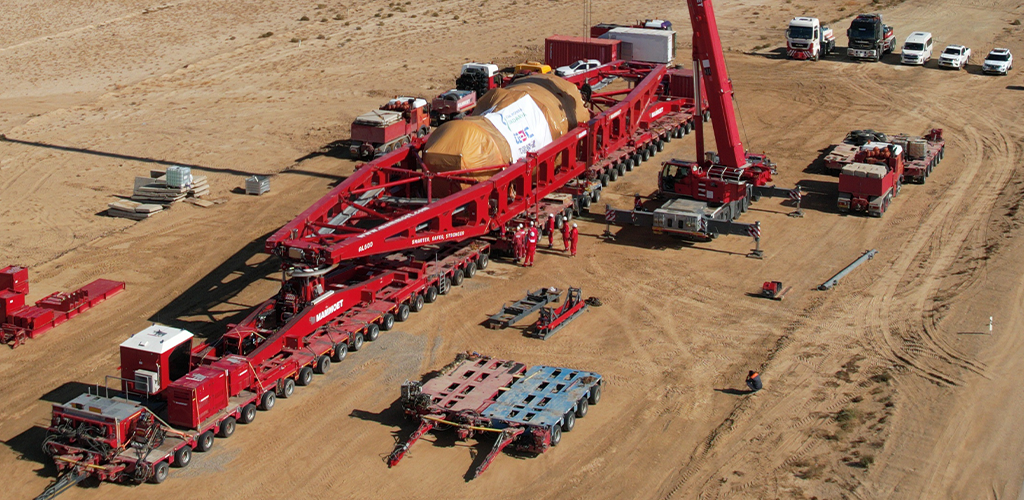Asia-Europe Initiative Described as “Lifeline for Logistics”
by Felicity Landon

In August 2024, the dredging group Jan De Nul announced the construction of a new deep sea port in Anaklia, Georgia, as well as the expansion of the ports of Kuryk, Kazakhstan and Mersin in Türkiye.
Together, said Jan De Nul, these projects would provide a significant boost to the Middle Corridor, also known as the Trans-Caspian International Transport Route (TITR).
“The maritime trade route through the Caspian and Black Seas is considered a reliable alternative to the northern route through Russia, or the southern route via the Suez Canal. However, the existing sea ports currently act as bottlenecks for cargo traversing the route,” said the company, adding that the three port projects “will effectively address the challenges.”
Stefan Muntoiu, business development manager at Jan De Nul Group, said: “These projects will have a big economic impact on the region. The Turkish, Georgia and Kazakhstan governments made firm decisions. We are proud to take part in the development of this important trade route.”
The Middle Corridor isn’t a new concept, but it is attracting more attention, due in no small part to the impact of geopolitical events. The route runs via Kazakhstan, the Caspian Sea, Azerbaijan and Georgia; connections into Europe are overland through Türkiye to Mersin on the Mediterranean or Istanbul, for Southern Europe, or across the Black Sea to Constanta (Romania) and overland to Northern Europe. Another option, less attractive now, is via Ukraine’s Odessa Port then overland to Poland.
The Middle Corridor is said to be the shortest route between Western China and Europe and there has been investment in road and rail infrastructure. Nevertheless, there are drawbacks, not least in the huge distances overland, bottlenecks and delays at borders, and challenges around the falling level of the Caspian Sea.
Project logistics and transport management services provider Globalink Logistics has its CIS base in Almaty, Kazakhstan, with more than 1,500 staff in the region. CEO Siddique Khan says: “The Middle Corridor is vital for our operations and the economic development of the region.
“As Central Asia is landlocked and surrounded by countries with limited access, such as Iran and Russia, the Middle Corridor is a lifeline for trade and logistics. Its development is essential for making transport more cost effective and improving the ease of doing business.

Great Advancements Expected
“For over 25 years, Globalink has been navigating this corridor, witnessing significant progress. However, there is still much more to be achieved, and we expect even greater advancements in the next five years, which will benefit the entire logistics industry.”
The Middle Corridor has seen exponential growth, particularly with the shift in global supply chains due to the Russia-Ukraine conflict, says Khan. “However, key challenges remain – insufficient infrastructure development along certain stretches of the route, delays in harmonizing customs procedures across countries, limited capacity to handle increasing cargo volumes, port facilities requiring upgrades to accommodate oversized and heavyweight cargo, and navigating fluctuating regional, geopolitical and regulatory environments, which can impact transit times and costs.”
In 2017, the company signed an MoU to cooperate in developing Anaklia’s logistics terminals, but the project faced challenges. “Despite the delays in launching the project, we anticipate its revival will provide much-needed capacity for handling oversized cargo. Globalink has been involved in Anaklia’s planning and is ready to support its development.
“At Kuryk, we have been utilizing the terminals for various projects since 2014. While current infrastructure meets the basic needs, there is a lot of potential for growth through public-private partnerships to improve facilities. These upgrades will be critical to handling the growing volume of project and general cargo in the coming years,” says Khan.
Port expansion is crucial for enhancing the Middle Corridor, says Azwe Aliyez, managing director – Caucasus and Central Asia, at Trans Global Projects. Kuryk is being expanded to accommodate the increasing demand for oversized cargo, particularly due to the surge in regional trade through the Caspian Sea, he says.
As for Anaklia port, after years of uncertainty and shifts within the project’s consortium, the Georgian government ultimately canceled the original concession contract, relaunching it more recently. “Despite widespread speculation, no construction has yet begun, either in Kazakhstan or Georgia,” says Aliyez.
Gianti Logistics, based in Tbilisi, Georgia, was involved in the earlier phase of Anaklia port development, delivering and mobilizing dredging and other equipment for Van Oord, which was awarded a contract for dredging and reclamation works in 2018. Shortly after dredging operations commenced, the project came to a halt.
George Makhatadze, Gianti’s general manager, says: “Anaklia is going to be a big port for Georgia. It will have 16 meters depth, allowing bigger vessels, and that will help us a lot.”
Port Alternative
He welcomes the prospect of an alternative port to Poti, which he describes as a “headache” and expensive for moving project cargo. A lack of storage space means that project cargo must be moved to terminals outside the port, which creates high additional costs.
“You get a very small window to move project cargo out of the port; you have to source local trucks, for which the hiring costs are really high, and sometimes weather conditions or vessel delays then keep the trucks waiting.”
Victoria Lunga, sales manager at S&D Logistics, a Tbilisi-based freight forwarder, says that only after Georgia’s October 2024 elections will the situation regarding Anaklia port become clearer. “When the share participation and the fate of the construction of the Anaklia port are determined, only then will transport companies/forwarders, including S&D Logistics, be able to be involved in the development of the new port and infrastructure.”
This is about the development not only of the port, but also the entire economy of the state and its political weight and attractiveness for the Middle Corridor, she says.
Aliyez says that while Anaklia and Kuryk development will enhance port capacity for oversize and overweight cargo, the main challenges relate to the road and rail infrastructure along the Middle Corridor. “Although we are seeing significant improvements in this area, there is still considerable work to be done. That said, these developments are promising steps towards better facilitating such cargo, and we are optimistic about the future.
“The Middle Corridor has seen substantial growth due to geopolitical shifts, particularly affecting trade routes between China and Europe, and is supported by significant investments, including a $10 billion commitment from the EU for infrastructure improvements.”
TGP is focusing on several wind, solar, mining and chemical projects in the region. “Given the expected volume of supplies from East Asia, we are considering using the Middle Corridor for these projects. The transit time for container transportation via the Middle Corridor is nearly half that of traditional sea freight.
“The closure of the Suez Canal underscores the strategic importance of the Middle Corridor. With ongoing developments along this route, transit times are expected to decrease further, offering both cost and efficiency advantages. TGP is well-positioned to capitalize on these improvements, as we have offices in the region and are already engaged in major projects, making the Middle Corridor a preferred alternative for logistics solutions.”
Going the Distance
The main challenge is the long distances, he says, especially for over- dimensional and heavy project cargo. “The typical and preferred movement should be via ocean and river systems. Our regional market knowledge and project track record helps us to know exactly where the bottlenecks are and what type of cargo can be moved.
“We are constantly arranging new, and updating existing, route surveys in the region to understand the limits of the existing and newly-built infrastructure.”
Makhatadze says rail connections for the Middle Corridor are good in the CIS countries: “It’s just that it’s a really long way. There is a shortage of locomotives and rail wagons. Azerbaijan has started to buy more; Geroge was buying from Russia but now cannot [due to sanctions].
“We are promoting the Middle Corridor more and more. As people try to avoid Russia, they come to us with new problems and are taking up whatever the Middle Corridor can do. We have done a lot of shipments to Central Asia recently, especially to Uzbekistan, which has huge potential, including turbines, power generators and transformers. More and more shippers are finding they can deliver via Georgia to avoid the sanctions.”
Road upgrades in the region have helped, enabling Gianti to move much heavier and larger loads, with an increasing focus on project cargo, says Makhatadze.
For example, the Georgia and Azerbaijan sections of the strategically important E60 road are nearing completion and this will increase the capability of the route. Georgia’s topography adds challenges – the 70-kilometer section of the E60 required the construction of around 100 tunnels.
There are also border headaches, says Makhatadze. “Sometimes we lose three or four days at the border [between Georgia and Azerbaijan], because of the queues. Every day we see 1,000 trucks waiting in the queue for one border crossing and up to 400 at the other. Many of these trucks previously went from Kazakhstan to Russia, then Georgia; now it’s Kazakhstan, ferry, Azerbaijan, Georgia.”
There is also a shortage of ferries across the Caspian Sea, he adds: “We are often waiting two weeks. If there is stormy weather, the wait gets even worse.”
Lunga says the Middle Corridor will bring new opportunities for S&D, which will expand its fleet, team and branches. “We will be able to work not only locally, but also be able to control our services locally in other countries at the intersection of the Middle Corridor,” she says. “The prospects for the Middle Corridor are clearly visible. Due to emerging geopolitical events in the world, it is becoming an alternative, sometimes even the only route for transporting goods and cargo.”
Infrastructure Enhancements
Expansion at Anaklia and Kuryk will improve the ability to handle oversized cargo, says Lunga: “However, it is important to approach this issue more broadly. The infrastructure of the entire mechanism must work at every stage, from the berthing of the vessel to the recipient’s door.
“Along with the construction of ports, it is important to address the bottlenecks at the borders, systematize electronic data exchange databases and introduce separate checkpoints for the registration and passage of oversized cargo. All these actions should take place in parallel or even in advance before the start of port construction. Ultimately, at the moment of cutting the red ribbon, all systems must be open.”
As routes such as through Russia and via Suez are restricted, “this is the real occasion when we can grab an opportunity and handle cargo flow – general and OOG,” Lunga adds. The Middle Corridor offers an alternative route and an alternative option to sea freight. “Road freight is becoming almost the same for costs, just a little more expensive, but the transit time is impressively smaller.”
S&D customers are expressing interest: “They need short transit time and clear tracking. They can accept a higher rate, but only in the case of perfect service. We try to provide all of that but without sustainable partners and governmental support, it won’t work. I mean, for example, the OOG permits should be at normal, not inflated, prices.
“The Georgian permit is the most expensive – US$2,600 – when Azerbaijan, Turkish and Armenian permits are around $500-1,000. Such a cost doesn’t allow us to get as many projects as we want to.”
If the corridor is to work, solutions must be sustainable, she emphasizes. “Forwarders should provide as many options as they can, and service that is really all in, without any issues. Sure, major forwarders will be able to attract small companies, but this must be controlled.
“When partnership is built on responsibility, understanding the ultimate goal and compliance with agreements, then this alternative has every chance of success – and this is the sustainable solution.”
Editor’s note: At the time of publication, Georgia’s election results were in dispute, according to a Reuters report.
*Breakbulk Exhibitor
